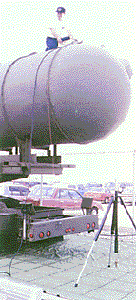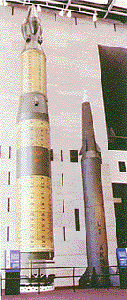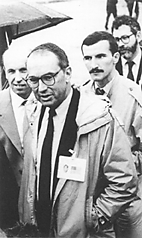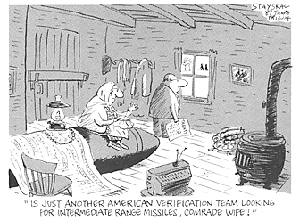| Inspections with Radiation Detection Equipment | ||
| During the
INF treaty negotiations, the Soviet Union indicated its
intention to convert some of its SS-20 missile operating
bases to SS-25 bases. The SS-25 was a fifth-generation
intercontinental ballistic missile that contained a
single warhead. It was road mobile, carried in a sealed
canister, and mounted on a transporter-erector-launcher.16 The SS-25's range
(10,500 kilometers) placed it outside the INF Treaty (500
to 5,500 km). However, the United States expressed
specific concerns during treaty negotiations. When the
SS-25 missile system was deployed in the field, with its
missile inside the canister and mounted on the launcher,
the U.S. contended that the canister might conceal an
SS-20 missile. The one distinguishing characteristic
between the two systems, U.S. treaty negotiators argued,
was that the SS-25 had a single nuclear warhead, while
the SS-20 had three warheads.17 After considerable discussion, the Soviet Union agreed to a provision in the treaty allowing the inspecting party the right to use radiation detection equipment to measure the fast neutron intensity flux emanating from the launch canister.18 A launch canister with a missile inside containing a single warhead (SS-25) emitted a different pattern of fast neutrons than did one with a missile having three warheads (SS-20). The American inspection team, using the RDE, compared their measurements against a set of benchmark radiation measurements taken during a special inspection in the summer of 1989. At that time, Commander Williams and a special INF inspection team had gone to two Soviet missile operating bases (one with SS-20s, the other with SS-25s) and had used the RDE to measure the emanations from the warheads in their canisters. The team's RDE benchmark measurement data, which were confirmed on site by their Soviet escorts, became the standard against which all subsequent RDE measurements were compared.19 In the Memorandum of Agreement of December 21, 1989, the USSR and the U.S. agreed on procedures on how RDE measurements would be taken during an on-site inspection. The inspection team had the right under the treaty to go to a former INF missile site that had been converted to a missile operating base for another system, set up its RDE, and measure only the exterior of the missile canisters to determine if the neutrons emanating indicated one or three warheads. For the entire period during which radiation measurements were being taken at the site, the party being inspected had the right to observe the process. Both parties, inspectors and escorts, recorded, processed, and made graphic representation of the RDE data.20 |
 An America inspector conducting training on the Radiation Detecting Equipment. |


